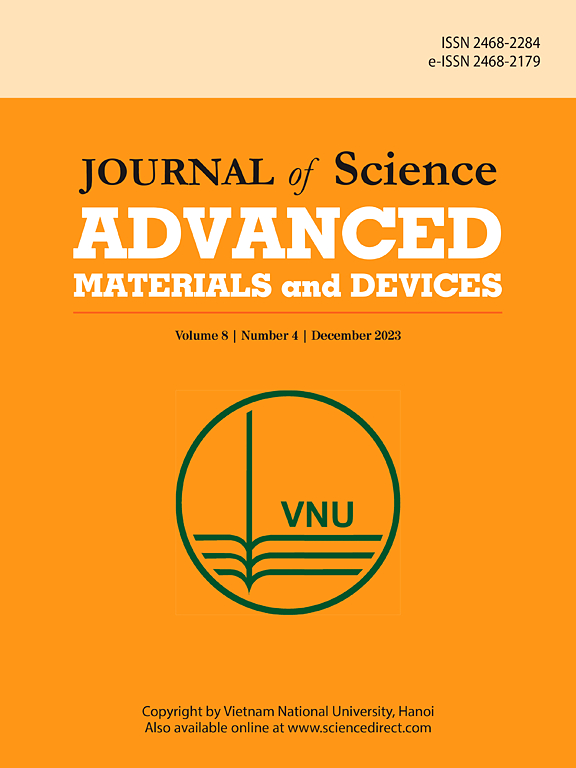Effect of Triton X-100 surfactant concentration on the wettability of polyethylene-based separators used in supercapacitors
IF 6.7
3区 材料科学
Q1 MATERIALS SCIENCE, MULTIDISCIPLINARY
Journal of Science: Advanced Materials and Devices
Pub Date : 2024-10-09
DOI:10.1016/j.jsamd.2024.100801
引用次数: 0
Abstract
Polyethylene-based separators are generally unsuitable for aqueous supercapacitors due to their poor wettability with the electrolyte, which impedes ion transport. However, incorporating Triton X-100 (2-[4-(2,4,4-trimethylpentan-2-yl)phenoxy]ethanol) into the aqueous sulfuric acid (H2SO4) electrolyte improves the wettability of polyethylene and facilitates ionic movement through its pores. In this study, Triton X-100 was added to 1.0 M H2SO4 at various concentrations (0.122%–1.210% V/V) to evaluate its impact on supercapacitor performance. Supercapacitors were assembled using activated carbon-filled carbon cloth electrodes, each of the above electrolytes and polyethylene sheet separators. Scanning electron microscopy revealed that the carbon cloth exhibited a uniform fiber distribution and high surface area for activated carbon integration. The polyethylene separator displayed a porous structure with an average pore size of 165 ± 35 nm. Triton X-100 significantly reduced the water contact angle from 101.5° (without surfactant) to 30.2° (with 1.21% V/V Triton X-100), enhancing polyethylene’s wettability. This change from hydrophobic to hydrophilic characteristics enabled the formation of an electrical double layer at the separator/electrolyte interface, improving ionic transport. However, higher Triton X-100 concentrations increased the electrolyte's viscosity, which impeded ion movement. The highest specific capacitance of 55.3 F/g (at a scan rate of 0.005 V s−1) was achieved with 0.488% V/V Triton X-100. The specific capacitance varied with surfactant concentration in a complex manner, influenced by micelle formation and precipitation. These findings were corroborated by cyclic voltammetry and AC impedance spectroscopy.
Triton X-100 表面活性剂浓度对超级电容器所用聚乙烯基分离器润湿性的影响
聚乙烯基隔膜通常不适合用于水性超级电容器,因为它们与电解质的润湿性较差,会阻碍离子传输。然而,将 Triton X-100(2-[4-(2,4,4-三甲基戊烷-2-基)苯氧基]乙醇)加入硫酸(H2SO4)水溶液电解液中可改善聚乙烯的润湿性,促进离子通过其孔隙运动。本研究在 1.0 M H2SO4 中添加了不同浓度(0.122%-1.210% V/V)的 Triton X-100,以评估其对超级电容器性能的影响。超级电容器使用活性碳填充碳布电极、上述每种电解质和聚乙烯片状隔板组装而成。扫描电子显微镜显示,碳布的纤维分布均匀,活性碳集成表面积大。聚乙烯分离器显示出多孔结构,平均孔径为 165 ± 35 nm。Triton X-100 大大降低了水接触角,从 101.5°(不含表面活性剂)降至 30.2°(含 1.21% V/V Triton X-100),增强了聚乙烯的润湿性。这种从疏水到亲水特性的变化使分离器/电解质界面形成了电双层,从而改善了离子传输。然而,Triton X-100 浓度越高,电解液的粘度就越大,从而阻碍了离子的移动。0.488% V/V Triton X-100 的最高比电容为 55.3 F/g(扫描速率为 0.005 V s-1)。比电容随表面活性剂浓度的变化而变化,受胶束形成和沉淀的影响。循环伏安法和交流阻抗光谱法证实了这些发现。
本文章由计算机程序翻译,如有差异,请以英文原文为准。
求助全文
约1分钟内获得全文
求助全文
来源期刊

Journal of Science: Advanced Materials and Devices
Materials Science-Electronic, Optical and Magnetic Materials
CiteScore
11.90
自引率
2.50%
发文量
88
审稿时长
47 days
期刊介绍:
In 1985, the Journal of Science was founded as a platform for publishing national and international research papers across various disciplines, including natural sciences, technology, social sciences, and humanities. Over the years, the journal has experienced remarkable growth in terms of quality, size, and scope. Today, it encompasses a diverse range of publications dedicated to academic research.
Considering the rapid expansion of materials science, we are pleased to introduce the Journal of Science: Advanced Materials and Devices. This new addition to our journal series offers researchers an exciting opportunity to publish their work on all aspects of materials science and technology within the esteemed Journal of Science.
With this development, we aim to revolutionize the way research in materials science is expressed and organized, further strengthening our commitment to promoting outstanding research across various scientific and technological fields.
 求助内容:
求助内容: 应助结果提醒方式:
应助结果提醒方式:


